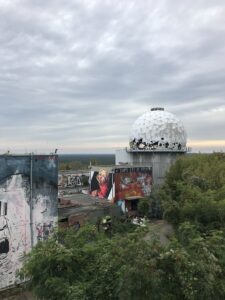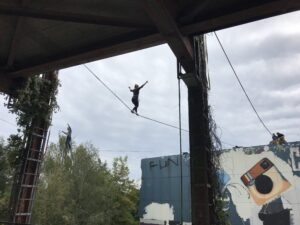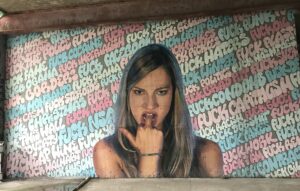It took Berlin twenty years to remove all the World War Two debris that resulted from the bombing of the city. Over 98 million cubic yards of the debris was repurposed in the construction of a man-made hill in Berlin named Teufelsberg, or Devils Mountain. The hill served two main purposes; it was used as a site to dispose of rubble, as well as used to physically bury the Nazi Military-Technical academy. During the Cold War, Teufelsberg was home to one of the largest American NSA Surveillance Spy Stations, as the hill was the highest point in Berlin. After Reunification in 1990, the Spy Station was sold to investors to be rebuilt as apartments, however, the funding fell through and the station became heavily graffitied and vandalized until 2010, when it started to be preserved as a graffiti gallery.
Since 2016, the abandoned station is open to the public, and it currently serves as a constantly-evolving Street Art Gallery. Teufelsberg is not a museum and presents no information about its history, instead, visitors are free to interpret its historical significance for themselves as they wander throughout the abandoned spy station with few restrictions. However, the station is hard to access, as it is in Berlin’s largest forest and is situated on Berlin’s highest hill, resulting in many local Germans, such as my host family, never having dedicated a day to trek out to the site. The visitors who do make the trek tend to be either younger well-informed tourists, or younger local Berliners. A few of us Carleton students decided to make the trek, and it was worth it.
I believe, after having been in Berlin for almost three months, that Teufelsberg is one of the most honest representations of Berlin’s culture. The site accepts its dark history as an abandoned Cold War Spy Station that covered an old Nazi Military Academy using rubble from the Berlin bombings, yet it has been able to be transformed by modern Berlin culture into a vibrant and colorful piece of artwork that fosters conversations about society. Every surface appears to be covered in layers of graffiti, with pictures of the station varying week by week due to new artworks that keep the conversations current. World-famous graffiti artists will leave their mark on Teufelsberg, with the realization that it could be covered the next week. There is no censorship of the graffiti, rather there is an open dialogue that addresses the typical taboos in modern society; sex, drugs, race, politics, and religion.
We saw many groups of local Berliners who were embracing this reclaimed site as a place to socialize or discuss the issues of the day, with some groups walking on tightropes between the buildings, some relaxing on roof-top couches, some playing music in the highest tower, and some working on their own graffiti artworks. This truly is a reclaimed piece of history that is shaped by modern culture in a way that perfectly integrates into the Berlin of today.









